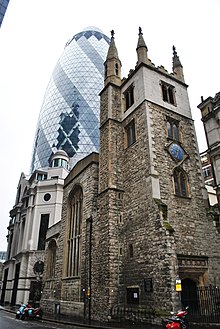St Andrew Undershaft
| St Andrew Undershaft | |
|---|---|
 St Andrew Undershaft in 2013 | |
 | |
| Location | St Mary Axe, London |
| Country | England |
| Denomination | Church of England |
| Previous denomination | Roman Catholic |
| Architecture | |
| Heritage designation | Grade I listed building |
| Style | Perpendicular style |
| Administration | |
| Diocese | London |
St Andrew Undershaft is a Church of England church in the City of London, the historic nucleus and modern financial centre of London. It is located on St Mary Axe, within the Aldgate ward, and is a rare example of a City church that survived both the Great Fire of London and the Blitz.[1]
The present building was constructed in 1532 but a church has existed on the site since the 12th century. Today, St Andrew Undershaft is administered from the nearby St Helen's Bishopsgate church.
History

The first church on the site, which today is bordered by St Mary Axe and Leadenhall Street, was built in medieval times, being recorded in 1147.[2] It was rebuilt in the 14th century and again in 1532;[3] this third incarnation of the building survives today. It is in the Perpendicular style[4] with its entrance located at the base of its off-centre tower. The interior is divided into six bays, with many of the original fittings that survived Victorian renovation. Formerly, St Andrew Undershaft had one of London's few surviving large stained-glass windows, installed in the 17th century, but this was destroyed in the Baltic Exchange bombing in 1992.
The church's curious name derives from the shaft of the maypole that was traditionally set up each year opposite the church.[5] The custom continued each spring until 1517, when student riots put an end to it, but the maypole itself survived until 1547 when it was seized by a mob and destroyed as a "pagan idol".
St Andrew Undershaft is now administered from the nearby church of St Helen's Bishopsgate. St Andrew Undershaft was designated a Grade I listed building on 4 January 1950.[6]
The tower holds a peal of six bells in the key of G, with the tenor being cast in 1597 by Robert Mot. These are now hung dead (they can only be rung stationary) inside the tower.[7]
Organ

The organ was installed in 1696 by Renatus Harris. A swell was added in 1750 by John Byfield. There have been other restorations and enhancements by George Pike England in 1810–11 and 1826. Further work was carried out by William Hill, Speechly and J. W. Walker & Sons, and Rushworth and Dreaper. A specification of the organ can be found on the National Pipe Organ Register[8]
The organ is of such historic significance that it has been awarded a Grade I historic organ certificate by the British Institute of Organ Studies.
Organists
- William Goodgroome, 1696
- Philip Hart, 1697–1749
- John Worgan, 1749–1790
- Mary Allen, 1790–1836
- Richard Limpus, 1847
- William Rea, 1847–1858
- Elizabeth Stirling, 1858–1880
- C. F. Frye, 1880–1886
- W. M. Wait, 1887–1891
- Herbert George Preston, 1891–1912[9]
- William A. S. Ballard, 1913–1921[10]
Notable people associated with the church
- Sir Thomas Offley, Lord Mayor of London 1563-64, buried in 1582. The monument to Sir Thomas and his wife Joan (died 1578) survives in St Andrew Undershaft. Joan was a granddaughter of Sir Stephen Jennings, Lord Mayor, who funded the rebuilding of the church.[11]
- John Stow, author of the Survey of London: buried in 1605. The pen held in the hand of his alabaster monument is renewed annually by the Lord Mayor of London.
- Hugh Hamersley, Lord Mayor of London in 1627, whose memorial is in St Andrew Undershaft.
- Hans Holbein the Younger, a former parishioner of St Andrew Undershaft who was possibly buried in the church.
- Frederick George Blomfield, rector of St Andrew Undershaft (1853–1879), son of Charles James Blomfield (Bishop of London) and father of Dorothy Gurney (poet and hymnwriter).
- John Lawrence Toole, comedian who was born and christened in St Andrew Undershaft.
- Fabian Stedman the father of church bellringing was buried in St Andrew Undershaft.
Notes
- ^ "The Visitors Guide to the City of London Churches" Tucker,T: London, Friends of the City Churches, 2006 ISBN 0-9553945-0-3
- ^ "The London Encyclopaedia" Hibbert,C;Weinreb,D;Keay,J: London, Pan Macmillan, 1983 (rev 1993,2008) ISBN 978-1-4050-4924-5
- ^ "London:the City Churches" Pevsner,N/Bradley,S : New Haven, Yale, 1998 ISBN 0-300-09655-0
- ^ "The City of London Churches" Betjeman,J Andover, Pikin, 1967 ISBN 0-85372-112-2
- ^ Cobb,G “London city churches”: London, B T Batsford Ltd., 1977
- ^ Historic England. "Details from listed building database ({{{num}}})". National Heritage List for England. Retrieved 23 January 2009.
- ^ http://london.lovesguide.com/andrew_undershaft.htm
- ^ National Pipe Organ Register website.
- ^ Dictionary of Organs and Organists, First Edition, Frederick W. Thornsby, 1912
- ^ Dictionary of Organs and Organists, Second Edition. G. A. Mate, 1921
- ^ W.J. Thoms, A Survey of London written in the year 1598, by John Stow (Chatto & Windus, London 1876), p. 194.
